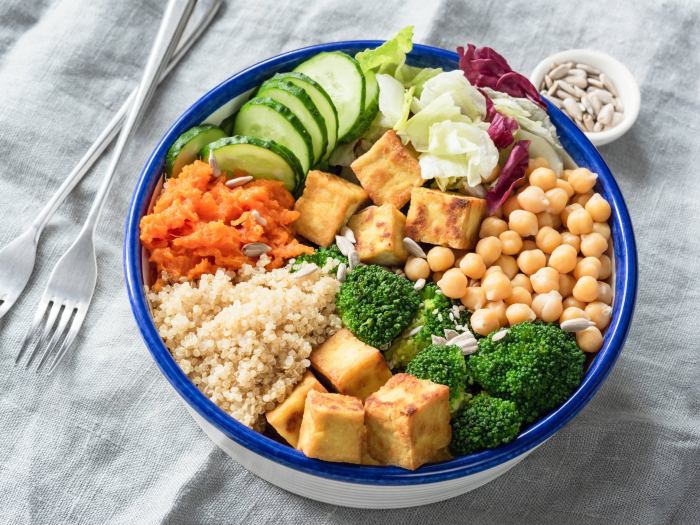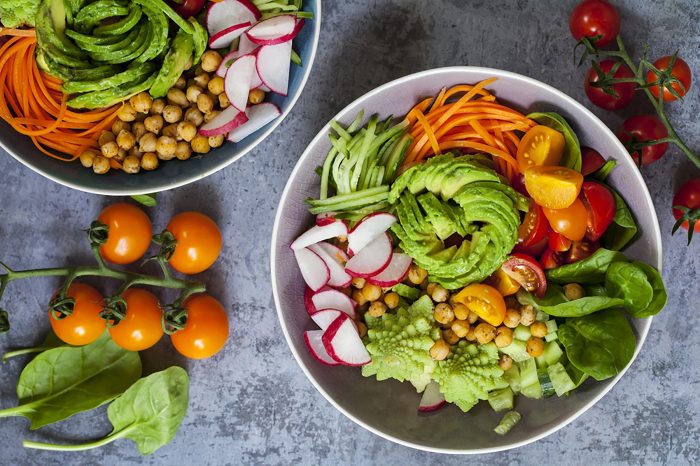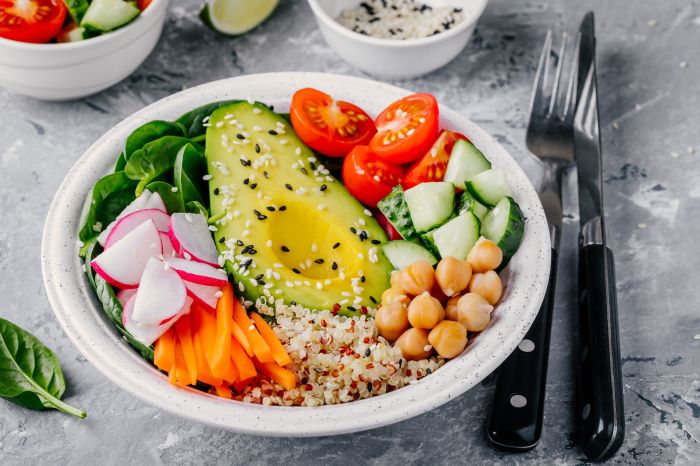As vegan diet meals take center stage, this opening passage beckons readers into a world crafted with good knowledge, ensuring a reading experience that is both absorbing and distinctly original. Vegan diet meals are a culinary celebration of plant-based ingredients, offering a symphony of flavors and an array of nutritional benefits.
From the essential nutrients found in vegan diets to the art of creating flavorful and nutritious vegan dishes, this comprehensive guide delves into the intricacies of plant-based eating. Discover the secrets of meal planning, recipe development, and the potential health benefits associated with embracing a vegan lifestyle.
Nutritional Value of Vegan Diet Meals
Vegan diets, characterized by the exclusion of animal products, provide a wealth of essential nutrients. Plant-based foods offer a comprehensive array of vitamins, minerals, antioxidants, and fiber, supporting overall well-being.
Plant-Based Protein Sources
Vegan diets emphasize plant-based protein sources, such as legumes (beans, lentils, chickpeas), tofu, tempeh, nuts, and seeds. These sources provide essential amino acids, the building blocks of protein, and are rich in fiber and other nutrients.
Role of Vitamins and Minerals
Vegan meals are rich in vitamins and minerals, including vitamin C (found in fruits and vegetables), vitamin E (found in nuts and seeds), and vitamin K (found in leafy green vegetables). Additionally, vegan diets provide essential minerals such as iron (found in fortified cereals and leafy green vegetables), calcium (found in fortified plant-based milk and leafy green vegetables), and zinc (found in beans, lentils, and nuts).
Meal Planning for Vegan Diets

Creating balanced and satisfying vegan meals requires careful planning to ensure you meet all your nutritional needs. Here are some tips to help you get started:
Variety is key in a vegan diet to ensure you’re getting all the nutrients you need. Aim to include a variety of fruits, vegetables, whole grains, legumes, and nuts in your meals. This will help you get a wide range of vitamins, minerals, and antioxidants.
Portion Control
Portion control is also important for a healthy vegan diet. It’s easy to overeat on vegan foods, especially if you’re not used to eating a lot of plant-based foods. Pay attention to your portion sizes and make sure you’re not eating more than you need.
Meal Plans
Here are some sample meal plans that can help you get started with a vegan diet:
- For weight loss:Focus on eating plenty of fruits, vegetables, and whole grains. Limit your intake of processed foods, sugary drinks, and unhealthy fats.
- For weight gain:Include more calorie-dense foods in your diet, such as nuts, seeds, and avocados. You can also add vegan protein powder to your smoothies or shakes.
- For athletes:Make sure you’re getting enough protein and carbohydrates to support your training. Include plenty of fruits, vegetables, and whole grains in your diet, and consider adding vegan protein powder to your post-workout recovery drinks.
Recipe Development for Vegan Diet Meals

Vegan diet meals are becoming increasingly popular due to their health benefits and ethical considerations. Creating flavorful and nutritious vegan dishes requires a deep understanding of plant-based ingredients and their culinary applications. Here are some principles to consider when developing vegan recipes:
- Use a variety of plant-based ingredients:Incorporate a wide range of fruits, vegetables, legumes, nuts, and seeds to ensure a balanced intake of nutrients.
- Focus on whole, unprocessed foods:Prioritize fresh produce, whole grains, and legumes over processed vegan alternatives to maximize nutrient content.
- Experiment with flavors and textures:Vegan cooking offers a vast array of flavors and textures. Use herbs, spices, marinades, and sauces to create dishes that are both delicious and visually appealing.
Techniques for Incorporating Plant-Based Ingredients
Incorporating plant-based ingredients into vegan dishes requires specific techniques to ensure optimal flavor and texture. Here are some common methods:
- Soaking and sprouting:Soaking beans, lentils, and grains helps reduce cooking time and enhances nutrient absorption. Sprouting further increases nutritional value.
- Blending and pureeing:Pureeing fruits, vegetables, and nuts creates smooth and creamy textures, making them ideal for sauces, soups, and smoothies.
- Fermentation:Fermenting plant-based foods, such as soy milk into yogurt or vegetables into sauerkraut, enhances their nutritional profile and adds depth of flavor.
Step-by-Step Recipe: Vegan Shepherd’s Pie, Vegan diet meals
Ingredients:For the filling:
Maintaining a healthy vegetarian diet requires careful planning to ensure you’re getting all the essential nutrients. Learn the secrets to eating healthy as a vegetarian by exploring our comprehensive guide.
- 1 tablespoon olive oil
- 1 onion, chopped
- 2 carrots, chopped
- 2 celery stalks, chopped
- 2 cloves garlic, minced
- 1 pound lentils, rinsed and picked over
- 1 cup vegetable broth
- 1/2 cup tomato paste
- 1 teaspoon dried thyme
- 1/2 teaspoon dried rosemary
- Salt and pepper to taste
For the topping:
- 1 pound potatoes, peeled and mashed
- 1/4 cup unsweetened almond milk
- 1 tablespoon vegan butter
Instructions:
Adopting a vegetarian lifestyle doesn’t mean sacrificing a healthy and balanced diet. In fact, with the right knowledge, you can thrive on a plant-based diet. If you’re new to vegetarianism, it’s essential to learn how to eat healthy as a vegetarian to ensure you’re getting all the nutrients your body needs.
- Preheat oven to 375°F (190°C).
- In a large skillet, heat the olive oil over medium heat. Add the onion, carrots, celery, and garlic and cook until softened.
- Add the lentils, vegetable broth, tomato paste, thyme, rosemary, salt, and pepper to the skillet. Bring to a boil, then reduce heat and simmer for 20 minutes, or until the lentils are tender.
- Spread the lentil mixture into a 9×13 inch baking dish.
- In a separate bowl, mash the potatoes with the almond milk and vegan butter. Spread the mashed potatoes over the lentil mixture.
- Bake for 30-35 minutes, or until the topping is golden brown.
Health Benefits of Vegan Diet Meals
Adopting a vegan diet offers numerous potential health benefits. By eliminating animal products, vegans consume a diet rich in plant-based foods, which are typically lower in saturated fat and cholesterol and higher in fiber, vitamins, minerals, and antioxidants.
One of the key health benefits associated with vegan diets is weight management. Plant-based foods are generally lower in calories and higher in fiber, which promotes satiety and helps individuals feel fuller for longer periods. This can lead to reduced calorie intake and subsequent weight loss or maintenance.
Role in Reducing Chronic Disease Risk
Research has shown that vegan diets may play a protective role in reducing the risk of developing certain chronic diseases. Studies have linked vegan diets to a lower risk of heart disease, type 2 diabetes, and some types of cancer.
- Heart Disease:Vegan diets are typically low in saturated fat and cholesterol, which are major contributing factors to heart disease. Plant-based foods are rich in fiber, which helps lower cholesterol levels and improve blood flow.
- Type 2 Diabetes:Vegan diets are high in fiber and low in refined carbohydrates, which helps regulate blood sugar levels and reduces the risk of developing type 2 diabetes.
- Cancer:Some studies have suggested that vegan diets may be associated with a lower risk of certain types of cancer, such as colon, prostate, and breast cancer. Plant-based foods contain antioxidants and phytochemicals that have been shown to have anti-cancer properties.
Challenges and Considerations for Vegan Diet Meals
Embracing a vegan diet can present various challenges and considerations that require mindful navigation. Individuals transitioning to a plant-based lifestyle may encounter common obstacles, such as nutrient deficiencies, social situations, and dining out experiences. Addressing these challenges proactively can ensure a successful and fulfilling vegan journey.
Addressing Nutrient Deficiencies
Vegan diets eliminate animal-derived products, which can lead to potential nutrient deficiencies. It is crucial to be aware of these potential shortfalls and take proactive measures to supplement or consume fortified foods. Common nutrients of concern include:
- Vitamin B12: Found exclusively in animal products, it is essential for nerve function and red blood cell production.
- Iron: Plant-based iron is less absorbable than heme iron from meat. Including iron-rich foods and enhancing absorption with vitamin C is vital.
- Calcium: While leafy greens provide calcium, fortified plant-based milks and supplements may be necessary to meet daily requirements.
- Omega-3 fatty acids: Alpha-linolenic acid (ALA) from plant sources can be converted into EPA and DHA, but supplementation with algae-based omega-3s may be beneficial.
- Protein: While plant-based sources like beans, lentils, and tofu provide protein, it is essential to combine different sources to ensure all essential amino acids are met.
Final Conclusion

In the tapestry of healthy eating, vegan diet meals stand as a vibrant thread, offering a path to nourishment and well-being. By embracing plant-based ingredients, individuals can unlock a world of culinary delights while reaping the rewards of improved health and sustainability.
As the popularity of veganism continues to soar, this guide serves as an indispensable resource for anyone seeking to embark on this transformative journey.
Questions and Answers
What are the essential nutrients found in vegan diets?
Vegan diets provide an array of essential nutrients, including protein, iron, calcium, vitamin B12, and omega-3 fatty acids. Plant-based sources of these nutrients include legumes, tofu, tempeh, leafy green vegetables, fortified plant milks, and algae.
How can I ensure I’m getting enough protein on a vegan diet?
Incorporating a variety of plant-based protein sources into your meals is key. Good sources of vegan protein include beans, lentils, tofu, tempeh, quinoa, and nuts.
What are some tips for creating balanced and satisfying vegan meals?
To create balanced vegan meals, aim for a plate that includes a variety of colors and textures. Include whole grains, legumes, vegetables, fruits, and healthy fats. Don’t forget to add herbs and spices for flavor.